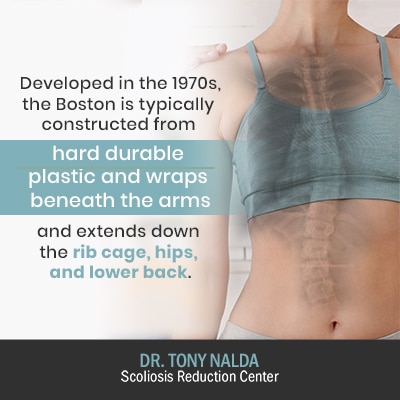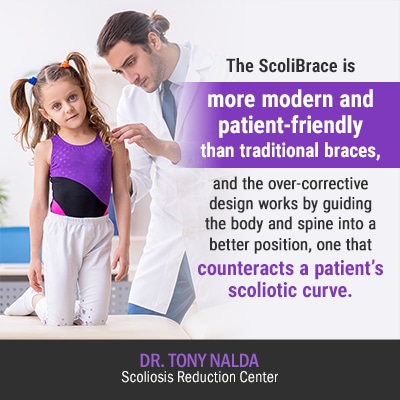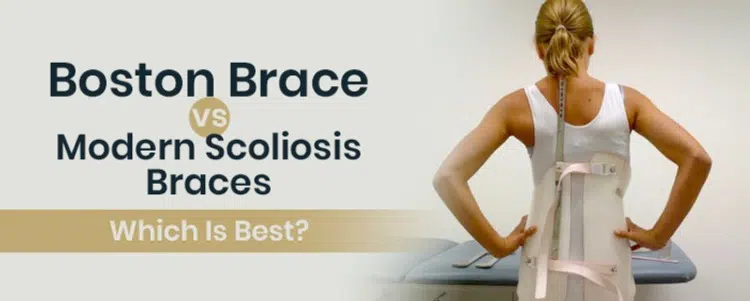When it comes to deciding on a scoliosis treatment approach to commit to, I encourage all patients to ensure they are aware of all treatment options available to them. This is important because different treatment approaches offer patients different potential outcomes, and as scoliosis is progressive, that choice can have life-long consequences; the same can be said of scoliosis braces. There are significant differences between traditional braces like the Boston and modern braces like the ScoliBrace.
The Boston Brace Original is the most commonly-used traditional scoliosis brace in the United States and has the end goal of stopping conditions from progressing. The modern corrective ScoliBrace represents a new era of scoliosis bracing as its innovative design addresses some of the shortcomings of traditional bracing.
Before we move on to the specifics of comparing traditional and modern scoliosis braces, let’s start with a general discussion on scoliosis itself for a clearer understanding of the place of bracing in scoliosis treatment.
Understanding Scoliosis
With close to seven million people currently living with scoliosis in the United States alone, it’s important to understand some of the condition’s general characteristics.
For example, while most know that having scoliosis means having an abnormally-curved spine, many don’t realize it’s a 3-dimensional condition.
In fact, in order for a scoliosis diagnosis to be given, the spine doesn’t just need to have an abnormal sideways spinal curvature of a certain size, but also has to include rotation. A scoliotic spine doesn’t just bend sideways but also twists from front to back and back to front.
It’s important to understand scoliosis as a 3-dimensional condition because in order for any form of treatment to be effective, it has to address it as such, and certain approaches and types of braces only treat the condition as 2-dimensional.
Other important condition characteristics to understand is that scoliosis can range greatly in severity from mild to moderate and severe to very severe; this is determined by the size of the abnormal spinal curve and a measurement known as Cobb angle.
Scoliosis is also progressive, meaning it’s in its very nature to worsen over time, especially if left untreated, or not treated proactively, so effective treatment has to counteract the curvature’s tendency to increase in size and stay ahead of patients’ progressive lines.
There are also multiple types of scoliosis a person can develop. While 80 percent of diagnosed cases are classified as ‘idiopathic,’ meaning not associated with a single-known cause, the remaining 20 percent have known causes: neuromuscular, degenerative, congenital, and traumatic.
The type of scoliosis is important because causation, when known, can guide the crafting of treatment plans moving forward.
The condition’s most-prevalent form is adolescent idiopathic scoliosis (AIS), diagnosed between the ages of 10 and 18, and it’s this age group that bracing is the most effective with as they have not yet reached skeletal maturity.
Scoliosis is a structural condition, meaning it has to be impacted on a structural level as part of treatment efficacy.
As mentioned, different types of treatment approaches produce different potential outcomes, and different treatment approaches are associated with different types of scoliosis braces.
Before moving on to comparing traditional and modern scoliosis braces, let’s touch on the different scoliosis treatment approaches.
Scoliosis Treatment Approaches
There are two main scoliosis treatment approaches patients have to choose between: conservative and traditional. Each approach has a favored type of scoliosis brace that’s best aligned with their treatment goals.
Conservative Treatment Approach
The conservative treatment approach is what I offer patients here at the Scoliosis Reduction Center®, and this approach strives to preserve the spine’s overall health and function by reducing the curvature on a structural level and working towards providing the spine with optimal support and stabilization.
The multifactorial nature of idiopathic scoliosis (thought to be caused by multiple variables) necessitates an integrative treatment approach that combines multiple scoliosis-specific treatment disciplines for the most customized and effective results.
Adolescents are the most common age group to be diagnosed with scoliosis, and this age group is at risk for rapid-phase progression, and this is because the condition’s number-one trigger for progression is growth.
Adolescents who are in, or entering into, the stage of puberty are known to experience rapid and unpredictable growth spurts that have the potential to cause significant increases in curvature degree, which is why it’s so important to be proactive with treatment. This is why I believe in starting treatment as close to the time of diagnosis as possible.
While no treatment results can ever be guaranteed, early detection can increase chances of treatment success, and by combining scoliosis-specific chiropractic care, in-office therapy, custom-prescribed home exercises, and modern corrective bracing, the results we have achieved speak for themselves.
The end goal of a conservative treatment approach, also commonly referred to as a functional approach, is correction and stabilization, and achieving these things without the need for invasive spinal surgery.
Traditional Treatment Approach
While the traditional treatment approach has been the dominant one for many years, it has a different end goal and offers patients a very different outcome.
The main goal of the traditional approach is stopping progression, and while managing the condition’s progressive nature is always an important component of effective treatment, this is different from having the main goal of working towards correction and stabilization on a structural level.
Along the traditional path of scoliosis treatment, if a patient is diagnosed with mild scoliosis, they are commonly told that as their condition is mild, that it should merely be observed for further progression. This is done by returning periodically for physical exams and X-rays to see if, and how much, a spinal curvature has progressed.
The issue I have with this is that it can be wasting valuable treatment time. What happens if a teenager has a 3-month gap between assessments and, during that time, has a huge growth spurt that causes their condition to worsen quickly?
While early detection and proactive treatment can’t guarantee positive results, it most certainly increases the chances of treatment success. It’s much simpler to treat a small curvature while it is still small, is less rigid, and before the body has had time to adjust to its presence.
Along the traditional treatment route, watching and waiting are valued, and it’s not until a condition progresses from mild to moderate that any treatment efforts are made. The sole form of treatment that’s applied is traditional bracing in an attempt to stop the condition from progressing further.
However, traditional braces, like the Boston, have shortcomings. If bracing proves ineffective at stopping progression and the condition moves into the severe or very-severe condition-severity classification, patients are commonly funneled towards spinal fusion surgery.
While every surgery comes with its share of risks, spinal fusion is a costly, lengthy, and invasive procedure that carries a high risk of side effects and potential complications.
In addition, some patients are disappointed with the surgery’s cosmetic results, experience an increase in pain post-surgery, and are disappointed with the loss of spinal flexibility they experience.
A loss in spinal flexibility is a fairly common outcome as the procedure involves fusing multiple vertebrae together into one solid bone; this will involve the most-tilted vertebrae at the apex of the curve, and while doing this can eliminate progression in that area, what it can also do is limit movement in that area in terms of spinal flexibility.
Now that we have discussed the main differences in the two main scoliosis treatment approaches in terms of end goal and application, let’s move on to comparing the different types of braces favored by these different approaches to treating scoliosis.
As mentioned, the traditional approach favors the use of traditional braces such as the Boston brace, while the conservative approach prefers the use of the modern ScoliBrace. The Scolibrace can help in non-surgical and non-operative treatment of scoliosis, as well as being effective in controlling curve progression.
Let’s discuss the specifics of each type of brace, and then compare and address the query of which is best.
How Bracing Works
Bracing is a non-operative treatment for scoliosis that uses a custom-made orthotic device to support the spine and correct the curve. The primary goal of bracing is to prevent the curve from progressing to the point where surgery is recommended.
Bracing works by applying pressure to the outer edge of the curve, which causes the spine to straighten and pull away from the pressure. This pressure is achieved through the use of strategically placed pads and trim lines that are customized to fit the individual’s size and curve type, but traditional bracing just uses squeezing, which is not effective in reducing the curve, and barely helps to stop progression of the curve.
Learn more below about the traditional approach, and the more modern approach to scoliosis bracing.
Traditional Boston Brace
As mentioned, the most commonly-prescribed traditional scoliosis brace in the United States is the Boston brace, which focuses on abnormal spinal curvatures of the mid to lower spine, and this brace has stopping progression as its end goal. The Boston Brace was initially designed by professionals at Boston Children’s Hospital.

Developed in the 1970s, the Boston is typically constructed from hard durable plastic and wraps beneath the arms and extends down the rib cage, hips, and lower back. Dr. John Hall played a pivotal role in the development of the Boston Brace in collaboration with Mr. William Miller in 1972.
The way the Boston brace works is by squeezing the spine from the sides with strategically-placed pads that target certain points along the spine’s curvature; this is known as a three-point pressure system. The goal is that by squeezing the spine into a straighter alignment, it won’t progress further.
The Boston is commonly prescribed for full-time wear which can be anywhere from 18 to 23 hours a day for up to 5 years.
One of the shortcomings of this traditional design is that squeezing the spine can actually weaken it over time and lead to further problems, including increased postural deviation.
In addition, while measurements are taken to try and get the best possible fit with the Boston, it is mass-produced so is not fully customized to suit a patient’s body type and condition. This can mean a brace that’s bulkier, less comfortable to wear, and lead to challenges with compliance.
Regardless of a brace’s goal or design, if it’s not worn properly as prescribed, its potential effectiveness is limited.
ScoliBrace: A Modern Corrective Boston Brace Alternative
The modern corrective ScoliBrace represents a new era for scoliosis bracing by addressing the shortcomings associated with traditional bracing, the condition’s 3-dimensional nature, and designing the brace around the end goal of correction. Choosing the right brace depends on several factors, including the type and location of the spinal curve. Factors to consider when choosing a brace include materials, pad placements, and reliefs. That is why we recommend the ScoliBrace.
While the main goal of the traditional Boston brace is to stop progression, the main treatment goal of the modern ScoliBrace is correction. Here at the Center, when I integrate the ScoliBrace into a treatment plan and combine it with other effective scoliosis-specific treatment disciplines, they can complement one another for the best results.
I want my young patients to experience relief, a spine that is more functional, and have less activity restrictions placed on them, and a conservative approach that includes the ScoliBrace can help achieve those results.
I provide my patients with the tools and techniques needed to work on strengthening the spine, helping it function optimally, and reduce the curvature on a structural level.
When bracing is needed for a patient, I commonly prescribe the ScoliBrace because it works by pushing the spine into a corrective position, instead of squeezing it and potentially weakening the spine in a way that can negatively impact its function and overall health.
The effectiveness of the brace depends on how well the brace fits and how well the patient adheres to the treatment plan.
When choosing between the Boston Brace and modern scoliosis braces, it is essential to consider the individual patient’s needs and preferences.
Boston orthotics prosthetics play a crucial role in the customization and effectiveness of the Boston Brace.

The ScoliBrace is more modern and patient-friendly than traditional braces, and the over-corrective design works by guiding the body and spine into a better position, one that counteracts a patient’s scoliotic curve.
The ScoliBrace opens and closes easily at the front and is available in a wide range of colors and patterns so patients customize the look of their brace.
As the ScoliBrace works to reduce the abnormal spinal curvature, it’s also known to address condition-related postural asymmetries such as the presence of a rib arch, uneven shoulders, and an uneven waistline.
As discussed earlier, the rotational element in a scoliotic curve makes it a 3-dimensional condition, and the ScoliBrace, unlike traditional braces, treats it as such. In order to impact a scoliotic curve on every dimension, the ScoliBrace is 100-percent customized to each patient’s body and curvature type.
To ensure each brace is as bespoke to its specific wearer as possible, ScoliBrace uses BraceScan that combines 3D full-body laser-scanning technology, postural photos, and X-ray images for a truly customized fit.
Each brace uses Computer-Aided Design (CAD) to address the specifics of each patient and their condition, and the braces are made with Computer-Aided Manufacture (CAM).
Thanks to the precision applied in the design of each and every ScoliBrace and the state-of-the-art technology aiding in the measurement and design process, ScoliBraces can be more corrective, comfortable to wear, easier to move in, and more likely to be worn as prescribed.
Choosing the Right Scoliosis Brace
Choosing the right scoliosis brace depends on several factors, including the type and location of the spinal curve, the patient’s age and stage of growth, and the severity of the curve. The decision should be made in consultation with an orthopedic specialist who can assess the patient’s individual needs and recommend the most effective treatment option.
Factors to consider when choosing a brace include materials, pad placement, and reliefs, as well as the patient’s lifestyle and preferences. Maximizing compliance is also an important consideration, as the effectiveness of the brace depends on how well the patient adheres to the treatment plan.
Conclusion
So which is best: the traditional Boston brace, or the modern ScoliBrace? While both types of braces have a place in scoliosis treatment, the answer to that question will depend on the desired treatment approach and outcome.
While no treatment results can ever be guaranteed, the Boston is more likely to work towards impacting a condition in terms of its progression, while the ScoliBrace can achieve corrective results.
In addition, as discussed, traditional braces that attempt to control progression by squeezing the spine from the sides can lead to a weaker spine and increased postural deviation, such as an over-exaggerated rib arch.
As the Boston brace is not custom-designed to the same level of the ScoliBrace, it’s more suited to a certain body type, and if a brace is too tight, it can lead to breathing difficulties, cause an increased rib arch, and restrict and weaken a patient’s spine and abdomen.
It’s also important to understand that different types of scoliosis braces reflect the treatment approach being applied, and the traditional approach to scoliosis treatment that relies on traditional braces, like the Boston, won’t be integrating other proactive treatment disciplines that work towards strengthening and stabilizing the spine as part of treatment.
Many patients who have worn the Boston brace describe issues such as restricted breathing, sore and tight hip muscles, red and sore skin, feeling overheated, mobility restrictions, and difficulties exercising.
So while the Boston brace can work towards stopping progression, the design of the brace itself can lead to other problems, including compliance.
As the modern ScoliBrace uses state-of-the-art technology and techniques to design fully-customized braces, they tend to be more effective, comfortable, less bulky, and more likely to be worn as prescribed.
In addition, as the ScoliBrace has a different end goal that has guided its design, it addresses the condition’s true 3-dimensional nature so the whole spine is impacted.
With the ScoliBrace guiding the spine, instead of squeezing it, scoliotic curves can be reduced on a structural level, and if other scoliosis-specific treatment disciplines are being applied to strengthen and stabilize the spine simultaneously, the corrective ScoliBrace can be an important part of treatment efficacy.
Here at the Scoliosis Reduction Center®, I want my patients to have the best possible quality of life throughout treatment and beyond, and for the bulk of my young patients, the modern corrective ScoliBrace is more aligned with my treatment goals of correction, stabilization, and preserving the spine’s overall health and function.





